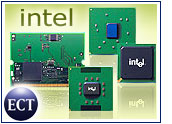
As the largest maker of computer chips, Intel has become the thermometer for monitoring the health of the technology sector. And according to the most recent temperature reading, the sector is feeling a bit down.
Intel lowered its revenue guidance substantially on Thursday, even more than analysts had predicted, and also said its profit margins were shrinking, the continuation of a trend some observers see as a red flag for the company.
Intel now says it will have sales of US$8.3 billion to $8.6 billion instead of the $8.6 billion to $9.2 billion range it set out back in July. Profit margins were reduced to 56 to 60 percent instead of 58 to 62 percent. The chipmaker’s shares were hammered by the news, trading as much as 8 percent lower on Friday morning.
The Santa Clara-based company made it clear that its performance was a reflection of the larger economic condition, not just in the U.S. but also around the world.
“What we are seeing is pretty uniform around the world,” CFO Andy Bryant said in a conference call. The drop-off is not dramatic and is most pronounced in the consumer part of the business, he added. “It’s moderate in scope.”
Revenue and Profit Shortfalls
Bryant said the revenue and profit shortfalls are not a result of Intel’s price cuts on some chip families announced last month, but instead are a function of reduced shipments.
Intel is rightly considered a bellwether because its products are the basic building blocks for technology used by both consumers and enterprises. If customers are buying Intel products, that generally means that more computers, servers and mobile devices are being produced and sold.
But some say the importance of Intel is magnified on Wall Street, where tech stocks often follow its lead.
That impact was clear Friday morning. While a decent jobs number for August — 144,000 jobs added — muted the effect of Intel’s lowered outlook some, the Nasdaq was down more than a percentage point while the Dow was trading near flat. Intel is part of the Dow Jones Industrial Average.
Almost every technology stock fell in Intel’s wake, from Hewlett-Packard and Dell — two of Intel’s biggest customers — to IBM and Microsoft.
Front of the Pack
Analysts say Intel is a good barometer for several reasons. In addition to being at the front of the curve in terms of technology, it is also strong in almost ever corner of the global marketplace. It often can smooth out softness in one part of the world with strong sales in growing markets.
“Intel has a balanced business model, both in terms of consumers and businesses and in terms of the global marketplace,” Gartner analyst Martin Reynolds told the E-Commerce Times. “They are the leader in virtually every market, so if they are feeling pain, it’s likely others are as well.”
In fact, several smaller chipmakers issued warnings on their results after Intel’s news broke, including memory chip producer Altera and Cypress Semiconductor.
Reynolds said periodic weakness is not unusual, but what might be rattling some investors is that the third quarter is normally one of the best for Intel and others in the sector because it includes the back-to-school rush and the start of the holiday shopping season, when computer makers and others typically gear up to meet demand.
Although quarterly comparisons “can be misleading,” the size of the downgrade could be significant enough to warrant further action to spur sales or cut costs if the trend continues, Reynolds added.
More Price Cuts Ahead?
Within the chip sector, some analysts said Intel might be prompted to cut prices to clear out inventories, especially if demand remains weak heading into the fourth quarter. The first and second quarters are seasonally weak ones for chipmakers, and they will want to act quickly enough to avoid being saddled with costly inventory at that time.
That could create a domino effect, analysts say, with competitors less able to absorb price cuts taking it on the chin. But other analysts said Intel might shoulder some of the responsibility for a weaker quarter.
Although it had a blockbuster second quarter with profit doubling, the company has seen some minor erosion of market share to number two AMD in recent quarters, has delayed some product releases and scrapped others, and hasn’t been able to generate consumer excitement about its high-end and high-profit performance chip lines. Analysts have been waving red flags about rising inventories and smaller profit margins since earlier in the year.
“Intel is generally an exemplary company in terms of execution and steering the market in the direction it wants it to go,” said Dean McCarron, president of Mercury Research. “But if the overall market isn’t expanding, even a small misstep can really be exaggerated in the final numbers.”























































Social Media
See all Social Media